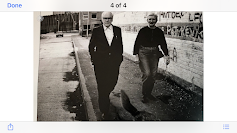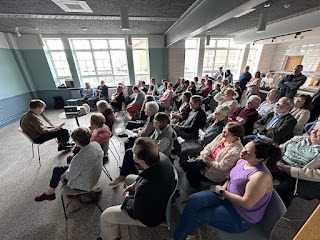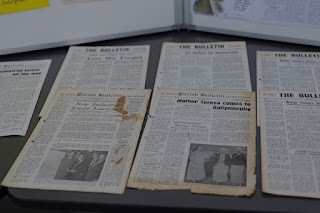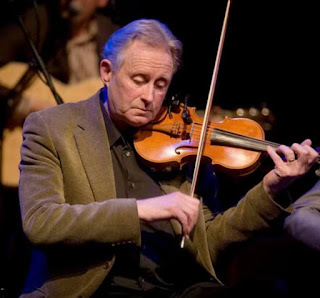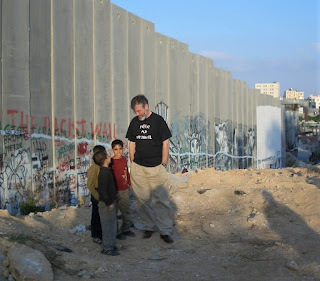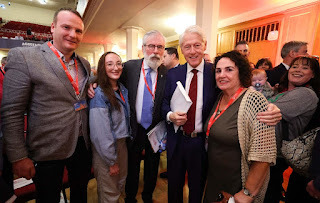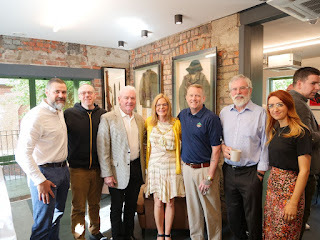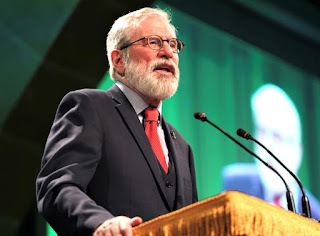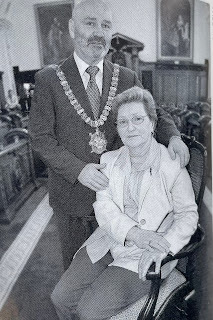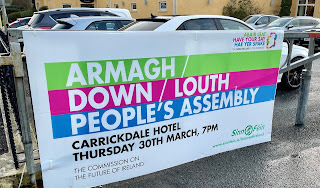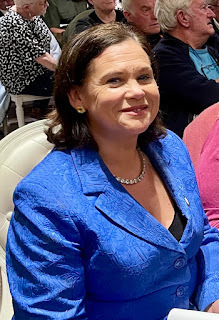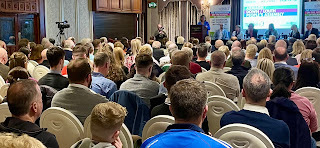Gerry Adams's Blog, page 12
May 21, 2023
The People���s Archive by The People���s Priest: Have your say on the future of Ireland: Se��n Keane: Walking with my Mother
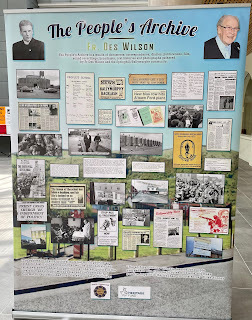
ThePeople���s Archive by The People���s Priest
Fr.Des Wilson died in November 2019. I first met him in 1968. His long life wasdedicated to helping people. During the years of conflict, he stood withthe Upper Springfield community against the aggression and violence of theBritish state forces. He gave comfort and solidarity to those in need andwas hugely respected and loved.
Fr.Des was the people���s priest, a community activist, an educator, a defender ofpeople���s rights, an author, dramatist and writer. He was also a man ofgreat courage, a good neighbour, and a decent human being.
On amore personal note in 1971, after internment, Fr. Des married Colette and mewhile I was on the run.
Lastweek the St. Comgall���s/Ionad Eileen Howell hosted an event celebrating Fr.Des���s life. On show were some of the 10,000 individual artefacts and documentsthat Fr. Des accumulated over his lifetime. Ciaran Cahill of SpringhillCommunity House explained that the Lottery Heritage Fund has agreed to supportthe cataloguing of Fr. Des���s archive.
Thisis a wonderful initiative providing an invaluable insight into the story of thecommunity of Upper Springfield and west Belfast and in particular of thenationalist working class communities. The aim is to preserve and curate thisarchive for future generations and researchers and to provide experience andtraining in archival methodology.
Fr. Des and Noelle Ryan
Fr.Des was a prolific writer, including a weekly column for this fine paper. Hewrote books and leaflets and pamphlets and collected posters, and photographsand locally produced community and political material.
As Iwandered around the tables where some of his material was laid out I wastransported back to the 1970s and 8o���s, to the trauma of internment and thetragedy of the H-Blocks and Armagh and of the hunger strikes. There wereposters and leaflets calling for the ban on plastic bullets and the end oftorture in RUC interrogation centres.
 Fr.Des kept a regular diary. Part of which he recorded on a twin-track taperecorder. It was sitting in pride of place in the middle of a table with theaccumulated dust of the years on it alongside some of the original tapes andposters. There was also a photograph of Fr. Des and Noelle Ryan whoworked closely with him over many years. Ciaran played for us a part of one ofDes���s diary recordings made shortly after the Ballymurphy Massacre in August1971 in which he spoke of his desire for a centre for reconciliation as amemorial to those who had been killed by the Parachute Regiment.
Fr.Des kept a regular diary. Part of which he recorded on a twin-track taperecorder. It was sitting in pride of place in the middle of a table with theaccumulated dust of the years on it alongside some of the original tapes andposters. There was also a photograph of Fr. Des and Noelle Ryan whoworked closely with him over many years. Ciaran played for us a part of one ofDes���s diary recordings made shortly after the Ballymurphy Massacre in August1971 in which he spoke of his desire for a centre for reconciliation as amemorial to those who had been killed by the Parachute Regiment.
The IrishPost in Britain carried a report of Fr. Des celebrating the 50th anniversaryof his ordination as a priest in September 1999. It includes a little poem fromhis good friend Fr. Joe McVeigh:
He���s a Celtand a Catholic, a
Buddhist anda Jew,
Arepublican, a socialist, and an anarchist too,
He���s apriest and a prophet,
A fighter tothe end ���
But most ofall.
Des Wilsonis our friend.
Itis clear just from the couple of dozen examples available last week that ThePeople���s Archive will be an important addition to the story of west Belfast andto the strength and vision of its people. Well done Ciaran, Claire Hackett andTiarnan O���Muilleoir, the archivist, and all of those involved in this veryimportant project. The exhibition will be on show at various locations over therest of the year, including during F��ile an Phobail. It you get a chance go andsee it.
Have your say on the future of Ireland
The Commission on the Future of Ireland wasestablished by Sinn F��in in November 2021. Its remit is to undertake a grassrootsconsultation with the people of Ireland and internationally on the future ofour island. For people to have their say on what the future might be.
So far the Commission has held four People���sAssemblies in Belfast, Derry, Ballybofey in Co. Donegal and the CarrickdaleHotel covering Louth, South Down and South Armagh. Independent Chairpersons anda wide range of political, economic, cultural and community contributors haveparticipated.
All of the events have been very well attended andpublic reports have been published. Videos of the event are available onYouTube. For example a video of the Donegal People���s Assembly is availableat: https://youtu.be/OUmR_pPnVt8
In June the Commission will be holding a Women���sAssembly in Belfast and a Youth Assembly in Dublin and we are planning two morePeoples Assemblies to be held in the South later in the year including one inthe Galway Gaeltacht.
The Commission has received over 150 written contributions froma broad range of interested individuals and groups.
If you want to make a contribution ��� to give youropinion on the shape and format of the new Ireland why not email the Commissionat commission@sinnfein.ie or via thefollowing webpage www.sinnfein.ie/ futureofireland
Walkingwith my Mother
Hereis another offering from a book of poetry - Poems for Hard Times ���I published a few years ago. This week I thought I would share this onewithyou.
Walking with my Mother
My mother died in 1992.
In 2007 I met her.
On the back road above Cashelnagore.
The August sunshine lit up
The scarlet fushia and the montbretia
And the white of her hair.
As I walked behind her
She picked wildflowers From the ditches.
Then at a gap in the hedge
She turned and smiled at me.
���L�� deas ata ann��� she said.
���It���s a nice day���.
I walked on.
Alone.
Wondering how this could be.
Se��nKeane.
Regular readers will know that this column is alover of music. My tastes are wide ranging and eclectic. But mostly I come backto folk music and invariably to Irish traditional music. And always when I���m inthat mood it���s The Chieftains for me. Last week I purchased Chronicles: 60Years Of The Chieftains on line from Claddagh Records.
I have been playing it constantly since then.Appropriately Paddy Maloney and his friends were belting out The MorningDew when I got the sad news of the death of Se��n Keane. Se��n died suddenly athome in Dublin. He was one of our foremost fiddle players and a constant part ofThe Chieftains since 1968. I have been one of his fans since then.
Se��n was the quiet, tall understated musical magicianwho brought old airs and traditional tunes alive. He was true to the traditionbut expert at weaving it into his own unique style. He was a musician���smusician. He has three solo albums Gusty���s Frolics, Se��nKeane and Jig it in Style. He and Matt Malloy, another genius,flute player and a Chieftain also, recorded Contentmentis Wealth. If you want Irish music at its best it���s worth a listen. So too areSe��n���s recordings with piper Liam O Flynn. He won many awards for hiswonderful music.
He was always delighted to be part of TheChieftains. They brought traditional music across the world. With them,Se��n also played alongside Mick Jagger, Kate Bush, Ry Cooder,Sting, Sinead O Connor and many other great performers.
His last public performance was the gig forPresident Biden down in Mayo weeks ago. I watched it on TV and I recall hishuge smile as they finished up one particularly boisterous set. I bumped intohim in the restaurant in Leinster House around the same time. I thanked him forhis service to our culture. I���m glad I did. He told me he was still playingwith Matt Malloy.
Paddy Glackin another wonderful fiddle player, in atribute to Se��n said that Se��n understood the ���emotional,spiritual and lonely quality in Irish traditional music.���
Se��n will be missed by everyone who appreciatestraditional music. Thankfully, because of his many recording, we canstill listen to him.
B�� mhaith liom mo comh bhr��n a dheanamh leis ateaghlach agus a cairde, go h���airithe na ceolteoir�� eile.
The People’s Archive by The People’s Priest: Have your say on the future of Ireland: Seán Keane: Walking with my Mother

ThePeople’s Archive by The People’s Priest
Fr.Des Wilson died in November 2019. I first met him in 1968. His long life wasdedicated to helping people. During the years of conflict, he stood withthe Upper Springfield community against the aggression and violence of theBritish state forces. He gave comfort and solidarity to those in need andwas hugely respected and loved.
Fr.Des was the people’s priest, a community activist, an educator, a defender ofpeople’s rights, an author, dramatist and writer. He was also a man ofgreat courage, a good neighbour, and a decent human being.
On amore personal note in 1971, after internment, Fr. Des married Colette and mewhile I was on the run.
Lastweek the St. Comgall’s/Ionad Eileen Howell hosted an event celebrating Fr.Des’s life. On show were some of the 10,000 individual artefacts and documentsthat Fr. Des accumulated over his lifetime. Ciaran Cahill of SpringhillCommunity House explained that the Lottery Heritage Fund has agreed to supportthe cataloguing of Fr. Des’s archive.
Thisis a wonderful initiative providing an invaluable insight into the story of thecommunity of Upper Springfield and west Belfast and in particular of thenationalist working class communities. The aim is to preserve and curate thisarchive for future generations and researchers and to provide experience andtraining in archival methodology.
Fr. Des and Noelle Ryan
Fr.Des was a prolific writer, including a weekly column for this fine paper. Hewrote books and leaflets and pamphlets and collected posters, and photographsand locally produced community and political material.
As Iwandered around the tables where some of his material was laid out I wastransported back to the 1970s and 8o’s, to the trauma of internment and thetragedy of the H-Blocks and Armagh and of the hunger strikes. There wereposters and leaflets calling for the ban on plastic bullets and the end oftorture in RUC interrogation centres.
 Fr.Des kept a regular diary. Part of which he recorded on a twin-track taperecorder. It was sitting in pride of place in the middle of a table with theaccumulated dust of the years on it alongside some of the original tapes andposters. There was also a photograph of Fr. Des and Noelle Ryan whoworked closely with him over many years. Ciaran played for us a part of one ofDes’s diary recordings made shortly after the Ballymurphy Massacre in August1971 in which he spoke of his desire for a centre for reconciliation as amemorial to those who had been killed by the Parachute Regiment.
Fr.Des kept a regular diary. Part of which he recorded on a twin-track taperecorder. It was sitting in pride of place in the middle of a table with theaccumulated dust of the years on it alongside some of the original tapes andposters. There was also a photograph of Fr. Des and Noelle Ryan whoworked closely with him over many years. Ciaran played for us a part of one ofDes’s diary recordings made shortly after the Ballymurphy Massacre in August1971 in which he spoke of his desire for a centre for reconciliation as amemorial to those who had been killed by the Parachute Regiment.
The IrishPost in Britain carried a report of Fr. Des celebrating the 50th anniversaryof his ordination as a priest in September 1999. It includes a little poem fromhis good friend Fr. Joe McVeigh:
He’s a Celtand a Catholic, a
Buddhist anda Jew,
Arepublican, a socialist, and an anarchist too,
He’s apriest and a prophet,
A fighter tothe end –
But most ofall.
Des Wilsonis our friend.
Itis clear just from the couple of dozen examples available last week that ThePeople’s Archive will be an important addition to the story of west Belfast andto the strength and vision of its people. Well done Ciaran, Claire Hackett andTiarnan O’Muilleoir, the archivist, and all of those involved in this veryimportant project. The exhibition will be on show at various locations over therest of the year, including during Féile an Phobail. It you get a chance go andsee it.
Have your say on the future of Ireland
The Commission on the Future of Ireland wasestablished by Sinn Féin in November 2021. Its remit is to undertake a grassrootsconsultation with the people of Ireland and internationally on the future ofour island. For people to have their say on what the future might be.
So far the Commission has held four People’sAssemblies in Belfast, Derry, Ballybofey in Co. Donegal and the CarrickdaleHotel covering Louth, South Down and South Armagh. Independent Chairpersons anda wide range of political, economic, cultural and community contributors haveparticipated.
All of the events have been very well attended andpublic reports have been published. Videos of the event are available onYouTube. For example a video of the Donegal People’s Assembly is availableat: https://youtu.be/OUmR_pPnVt8
In June the Commission will be holding a Women’sAssembly in Belfast and a Youth Assembly in Dublin and we are planning two morePeoples Assemblies to be held in the South later in the year including one inthe Galway Gaeltacht.
The Commission has received over 150 written contributions froma broad range of interested individuals and groups.
If you want to make a contribution – to give youropinion on the shape and format of the new Ireland why not email the Commissionat commission@sinnfein.ie or via thefollowing webpage www.sinnfein.ie/ futureofireland
Walkingwith my Mother
Hereis another offering from a book of poetry - Poems for Hard Times –I published a few years ago. This week I thought I would share this onewithyou.
Walking with my Mother
My mother died in 1992.
In 2007 I met her.
On the back road above Cashelnagore.
The August sunshine lit up
The scarlet fushia and the montbretia
And the white of her hair.
As I walked behind her
She picked wildflowers From the ditches.
Then at a gap in the hedge
She turned and smiled at me.
‘Lá deas ata ann’ she said.
‘It’s a nice day’.
I walked on.
Alone.
Wondering how this could be.
SeánKeane.
Regular readers will know that this column is alover of music. My tastes are wide ranging and eclectic. But mostly I come backto folk music and invariably to Irish traditional music. And always when I’m inthat mood it’s The Chieftains for me. Last week I purchased Chronicles: 60Years Of The Chieftains on line from Claddagh Records.
I have been playing it constantly since then.Appropriately Paddy Maloney and his friends were belting out The MorningDew when I got the sad news of the death of Seán Keane. Seán died suddenly athome in Dublin. He was one of our foremost fiddle players and a constant part ofThe Chieftains since 1968. I have been one of his fans since then.
Seán was the quiet, tall understated musical magicianwho brought old airs and traditional tunes alive. He was true to the traditionbut expert at weaving it into his own unique style. He was a musician’smusician. He has three solo albums Gusty’s Frolics, SeánKeane and Jig it in Style. He and Matt Malloy, another genius,flute player and a Chieftain also, recorded Contentmentis Wealth. If you want Irish music at its best it’s worth a listen. So too areSeán’s recordings with piper Liam O Flynn. He won many awards for hiswonderful music.
He was always delighted to be part of TheChieftains. They brought traditional music across the world. With them,Seán also played alongside Mick Jagger, Kate Bush, Ry Cooder,Sting, Sinead O Connor and many other great performers.
His last public performance was the gig forPresident Biden down in Mayo weeks ago. I watched it on TV and I recall hishuge smile as they finished up one particularly boisterous set. I bumped intohim in the restaurant in Leinster House around the same time. I thanked him forhis service to our culture. I’m glad I did. He told me he was still playingwith Matt Malloy.
Paddy Glackin another wonderful fiddle player, in atribute to Seán said that Seán understood the ‘emotional,spiritual and lonely quality in Irish traditional music.’
Seán will be missed by everyone who appreciatestraditional music. Thankfully, because of his many recording, we canstill listen to him.
Bá mhaith liom mo comh bhrón a dheanamh leis ateaghlach agus a cairde, go h’airithe na ceolteoirí eile.
May 15, 2023
Candidatitis: Solidarity with Palestinian people: Gaza
Candidatitis
I first published this article in 2007 and then, slightlyamended in 2016. And again last year. We are only a wee while away from thelocal government elections in the North. Sinn Féin is standing its largestnumber of candidates ever in this contest including the most firstcandidates. So I thought this would be a good time to republish itagain, slightly amended once more.
It is my tribute to the majority of candidates who won’t getelected. Think of them as you digest all the outcomes. Good luck tothem all. Good luck especially to Sinn Féin’s candidates. I hope we have agreat result.
That’s all in the gift of the electorate. So I thank allthe voters as well as all the candidates.
Opinion polls have become an integral part of every electioncampaign. Every newspaper and every broadcast outlet tries to second guess theelectorate by commissioning polls. And then their columnists or pundits spend ahuge amount of time analysing the poll they just commissioned.
So do many candidates. And their supporters. This can lead tomood changes and other character changing tendencies. This can be verystressful. So every candidate and everyone else should be mindful of theparticular and peculiar stresses and strains that come with being a candidate.It’s a form of ailment called Candidatitis. It begins withthe candidate coming to believe – with a certainty known only to the prophetsof old – that they are going to win.
This syndrome is capable of moving even the most rationalaspirant or shy wallflower into a state of extreme self belief. It strikeswithout warning, is no respecter of gender, and can infect the lowly municipalhopeful, the aspiring Parliamentarian, as well as the lofty presidentialwannabe.
I believe this is due to two factors. First of all most peoplestanding for election see little point in telling the voters that they are notgoing to win. That just wouldn’t make sense. Of course not. So they say theyare going to win.
That's when Candidatitis starts. Asthe 'we are going to win' is repeated time and time again itstarts to have a hypnotic effect on the person intoning the mantra. By thistime it’s too late.
Which brings me to the second factor. Most peopleencourage Candidatitis. Unintentionally. Not even the candidate’s best friend will say hold on,you haven't a chance. Except for the media. But no candidate believes themedia. And most candidates are never interviewed by the media anyway.
So a victim of Candidatitis will takesuccour from any friendly word from any punter. Even a 'good luck' takes on newmeaning and 'I won't forget ye' is akin to a full blooded endorsement.
So are we to pity sufferers of this ailment? Probablynot.
They are mostly consenting adults, although some partiesoccasionally run conscripts. In the main these are staunch party people who arepersuaded to run by more sinister elements who play on their loyalty andcommitment. In some cases these reluctant candidates run on the understandingthat they are not going to get elected. Their intervention, they are told, isto stop the vote going elsewhere or to maintain the party's representativeshare of the vote. In some cases this works. But in other cases, despiteeverything, our reluctant hero, or heroine, actually gets elected. A friend ofmine was condemned to years on Belfast City council years ago when his electioncampaign went horribly wrong. He topped the poll.
That’s another problem in elections based on proportionalrepresentation. Topping the poll is a must for some candidates. But in PRelections such ambition creates a headache for party managers. If the aimis to get a panel of party representatives elected they all have to come infairly evenly. This requires meticulous negotiations to carve upconstituencies. Implementing such arrangements make the implementation ofthe Good Friday Agreement look easy.
It means only placing posters and distributing leaflets inspecific areas with clear instructions to the electorate on how we would likethem to vote. In some elections I have noticed that some candidates (not SinnFéin candidates folks) putting up posters in their colleagues territory.Not a good sign.
It requires an inordinate amount of discipline on thecandidates' behalf not to fall into this trap. Many do. Some don’t. Some getreally sneaky. Particularly as the day of reckoning comes closer. Panic attacksand an allergy to losing can lead to some sufferers poaching a colleague'svotes. This is a very painful condition leading to serious outbreaks ofnastiness and reprisals and recriminations if detected before polling day. Itusually cannot be treated and can have long term effects.
So dear readers all of this is by way of lifting the veil onthese problems which infect our election contests. Politicians are a muchmaligned species. In some cases not without cause.
So the next time you look at a poster or get a leaflet throughthe letterbox or are confronted at your door by a wild eyed candidate –occasionally accompanied by a posse of cameras – then take a moretolerant and benign view of the sometimes strange behaviour of those citizenswho contest elections .
When you are accosted by a pamphlet waving candidate, asyou shop in the supermarket or collect the children at school or are mindingyour own business as you walk down the main street, try to see beyond the brashexterior. If they get carried away with themselves it’s not really theirfault you see. Big boys and girls make them do it.
Most candidates are decent well meaning civic mindedcitizens. It’s a pity some have awful politics. So your votes shouldnot encourage them. They will have difficulties enough dealing with defeat aswell as the outworking of Candidatitis. But they willrecover eventually.
If they get elected they or we may never recover. Please spareus from that.
Solidarity with Palestinian people
I want to extend my solidarity andcondolences to the Palestinian people and especially to the family of KhaderAdnan who died on the 2 May last week after 87 days on hunger strike. His deathin an Israeli prison, coming just three days before Irish republicanscommemorate and celebrate the life of Bobby Sands, was especially poignant.
As I read the reports of KhaderAdnan’s death I recalled Bobby’s words from his prison diary in which he wroteabout the battle between hunger, the lure of food and the desire for freedom. On17 March 1981 Bobby wrote: “Iwas thinking today about the hunger-strike. People say a lot about the body,but don’t trust it. I consider that there is a kind of fight indeed. Firstlythe body doesn’t accept the lack of food, and it suffers from the temptation offood, and from other aspects which gnaw at it perpetually.
Thebody fights back sure enough, but at the end of the day everything returns tothe primary consideration, that is, the mind. The mind is the most important.But then where does this proper mentality stem from? Perhaps from one’s desirefor freedom. It isn’t certain that that’s where it comes from. If they aren’table to destroy the desire for freedom, they won’t break you.”
And so it was for Khadar Adnan. The battle betweenthe temptation for food and the demand for freedom is one that he had foughtbefore. Adnan had previously been arrested 12 times by Israel and interned. Onseveral earlier occasions he had undertaken a hunger strike, including in 2015when he was 55 days without food.
Last week the father of nine was one of more thanone thousand Palestinian internees scattered in prisons across Israel and theoccupied territories. Every day there are reports of systematic abuse byIsraeli forces against the Palestinian people.
In our time 12 republican prisoners died on hungersstrike. Others died in previous generations. This Friday as we remember FrancieHughes who was the second republican hunger striker to die in 1981 let us alsoremember those others around the world, and especially living under Israel’sapartheid system, who also struggle for freedom.
To hiswife Randa Mousa, his children and family I extend the solidarity of Irishrepublicans.
Gaza
As I wrote this week of the pain of thePalestinian people I recalled a visit to the west Bank and to Gaza in 2009.Three years ago I published Poems forHard Times - a short selection of poems including one that I wrote duringthat visit. It is an appropriate reminder this week of the horror of Israel’sapartheid regime.
Gaza
Rubble on rubble
Twisted metal
And ghosts
Everywhere
Ghosts of little children
Playing in the ruins
Little ghosts
Páistí bochta
Laughing
Shouting
Crying
And dying In Gaza.
Gaza City 8 April 2009
Poems for HardTimes available from An Fhuiseog 55 Falls Road Béal Feirste BT12 4PD
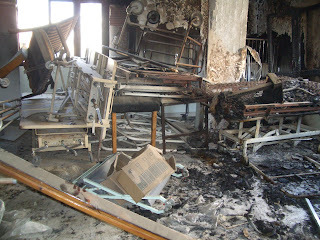
Hospital in Gaza destroyed in Israeli attack
May 7, 2023
Republican Women negotiators: Stardust families demand truth: A CoroNation Once Again
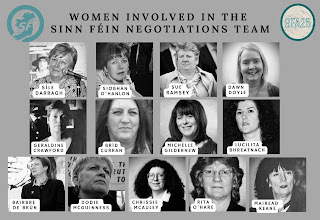
Republican Women negotiators.
The considerable media coverage ofthe 25 anniversary of the Good Friday Agreement frequently told the story ofthat negotiation through the words and voices of the leadership figures whoparticipated. When the role of women in the talk’s process was mentioned it wasalmost exclusively in the context of the participation of the Women’sCoalition.
While the Women’s Coalitionundoubtedly played its part the absence of any focus on the part played by themany women from the other parties did a disservice to their involvement. Duringmy contribution on the first day in the panel ‘Building Peace – the Parties’that was chaired by Ambassador Nancy Soderberg I took the opportunity to readout a list of those women comrades who were consistently part of Sinn Féin’snegotiating team.
They included Síle Darragh, SiobhánO’Hanlon, Sue Ramsay, Dawn Doyle, Geraldine Crawford, Bríd Curran, LucilitaBhreatnach, Bairbre de Brún, Dodie McGuinness, Chrissie McAuley, Rita O’Hareand Michelle Gildernew. Mairead Keane our first North America representativebased in Washington from 1995 also played a significant role in DC and with ourIrish American allies.
Stardust families demand truth
The inquest into the Stardustdisaster opened in Dublin last week. The list of the dead from that terribleevent in February 1981 is heartbreakingly long. The families of the 48 youngpeople who died have been reading poignant pen portraits of their loved onesinto the record of the inquest. All of those who were killed were aged between16 and 26. Over two hundred others were injured.
Forty two years after that appallingtragedy the Stardust families now have the opportunity, long denied them bysuccessive governments, to get to the truth of the events of that night.
The inferno that consumed the St.Valentine’s night disco in the Stardust at Artane left scores of familiesdevastated and the communities of Artane, Coolock and Donnycarney in NorthDublin reeling from the deaths of so many young people. Over 800 people hadbeen crammed into the venue. The trauma of those communities was compounded bythe subsequent decisions of state agencies to deny the families access to thetruth of what happened that night.
Accusations emerged quickly thatDublin Corporation had failed to carry out any fire safety inspections in theStardust, which had opened in 1978 and was one of the largest of such venues inthe state. On the night of the fire there were five emergency exit doors. Thesewere padlocked and had chains attached to prevent their being opened. Metalgrilles and steel plates covered the windows. People outside the building wereunable to pull these off to help those trapped inside.
The owner, Eamon Butterly, said thatit was normal for the emergency exits to be chained. However he claimed thatthe chains were taken off on disco nights. But on the night of the disaster thechains were in place and those fleeing the fire and smoke could not escape.
A tribunal of inquiry was heldchaired by Mr Justice Ronan Keane.Despite the Tribunal determining that there were severe fire violations andthat the owner acted with reckless disregard for the safety of his customers,Butterly received £580,000 punts in compensation. Why? Becausealthough there was no evidence to support a conclusion of arson the Tribunalruled that arson was probably to blame.
The Director of Public Prosecutionsalso decided that there were insufficient grounds to take action againstButterly. No one was held accountable for what occurred. The only person evertaken to court was Christy Moore who in July 1985 was found in contempt ofcourt for his song "They Never Came Home."
He was inspired to write the songafter hearing one of the mothers in an interview use that phrase. Hissong contained the following lines:
"In a matter of secondsconfusion did reign.
The room was in darkness, fire exitswere chained…”
"Hundreds of children areinjured and maimed,
and all just because the fire exitswere chained."
In addition EamonButterly claimed that the words; “Just how the fire started, sure no-one cantell" was not accurate. The court found for Butterly andChristy’s album had to be withdrawn.
In 1985 a compensation tribunal was established. To access compensation thefamilies had to relinquish their right to pursue any further legal action. Inaddition there were two Oireachtas-appointed reports. None of these actions bythe state satisfied the families who continued to demand truth. They organisedprotests, held vigils, and lobbied the political parties. Sinn Féin supportedthe families throughout this process.
A review (The Coffey Inquiry, 2008)ordered by the government concluded that the claim of arson was not "justifiableon the evidence". Following the publication of the report theDáil voted on 3 February 2009 to acknowledge that: “the cause of thefire is unknown, the original finding of arson is a mere hypotheticalexplanation and is not demonstrated by any evidence and that none of thepersons present on the night of the fire can be held responsible for it.”
It is now accepted that there was noarson and that the fire originated with an electrical fault in a first floorstorage room which did not have planning permission and held dangerousflammable material, including cooking oil. Despite the clear breaches offire safety regulations, the owners never faced charges. The fact thatButterly was a friend of then Taoiseach Charles Haughey has raised consistentallegations of a cover-up.
Eventually thecampaign by the Stardust families’ resulted in 2019 in then attorney generalSéamus Woulfe ordering a new inquest. This has now opened and is expected tolast six months and to hear evidence from hundreds of witnesses. The Dublincoroner Myra Cullinane has said she will not be bound by previousfindings of past inquiries and significantly, the High Court ruled last yearthat this inquest can include 'unlawful killing' as apotential verdict.
ACoroNation Once Again
This column supports the decision byFirst Minister Designate Michelle O Neill and Northern AssemblyCeann Chomairle Alex Maskey to accept the invite to attend the coronation ofthe English King Charles. They do so in their capacity as representatives ofall the people of the North.
The vast majority of people who havetalked to me about this agree with this initiative. Others do not agree. Iwould be worried if it was not so. Republicans are against unelectedhierarchies of all kinds, including monarchies. That would be the case even if,God forbid, there was a native Irish one. Even more so that we have someoneelse’s Royals foisted on us. Or that some of us have suffered grievously,including our neighbours and friends in Ballymurphy and Derry at the hands ofBritish paratroopers.
So it is no surprise that somerepublicans will be discommoded by Michelle and Alex’s attendance. Oneyoung person told me it was a step too far. But not everyone in theNorth or in the rest of Ireland is a republican. And our society is deeplydivided, not least because of English claims to jurisdiction here.
Despite these divisions we haveagreed that the people of our island will decide the future. My clearview, and Michelle and Alex’s, is that the union should be ended. Others have adifferent view. We have to persuade them of the merits of self determination.Any sensible citizen watching the recent punishment budget announcement bythe current British Secretary of State is bound to wonder why some local politiciansembrace this arrangement. We can’t afford the Union. Why shouldn’twe have our own tax gathering powers? Why can’t we set our own budget?
Surely it is obvious that wedon’t need an English Tory, or anyone else from England, to rule us.The cost of the union is too much. On all counts. The sooner it ends the betterfor us all. Notwithstanding the current stance of the DUP, we are wellable to govern ourselves once the shackle of English rule ends. The Good FridayAgreement referendum on the future will decide that. Governingourselves means everyone who lives here having respect and tolerance for eachother.
That’s what the First Minister andthe Assembly Ceann Chomairle’s acceptance of the coronation invite is about. Nomatter about their own personal and political or ideological view they areabout representing everyone as best they can. Those who expect a reciprocalgesture from the extremes of Unionism are naive. That is not therationale for this initiative. A First Minister for all is exactlythat. Michelle O Neill continues to hold and to act on her own republican viewsbut as First Minster Designate she is demonstrating her commitment to be aMinister for everyone.
On this occasion she, and Alex,will represent those who have a different attitude from them tomonarchies. Including people in England. Let’s lead by example
Good neighbourliness based onequality of relationships is possible within and between the people of theseislands.
This will truly flourish when we getto exercise our right to self determine our future. Speed the day.
May 2, 2023
Voting for the President: Agreement 25: In Praise Of Tulips: Earth Day ��� defending our natural environment
Voting for the President
This is not the only matter that the Irish Government is failing on. Dublin Castle was the venue last week of ���Together Again ��� Le Ch��ile Ar��s��� ��� the third of the Irish government���s Global Irish Civic Forums. These events bring together representatives of the Irish diaspora from across the world to promote a conversation on issues of concern and interest to the diaspora.
Another issue of concern that has been repeatedly put on the back burner by the government for the last decade is that of voting rights in Presidential elections for Irish citizens living outside of the southern state, in the North and in the diaspora.
Votingrights.ie is a group advocating for Presidential voting rights for Irish citizens within the diaspora. During the Global Irish Civic Forum event they raised this in a letter to the T��naiste Miche��l Martin. The group expressed its ���disappointment that a referendum granting citizens living outside the state the right to vote in future Presidential elections has been kicked to touch once again, and is now scheduled for 2025."
Votingrights.ie point out that this will mean that the earliest election these citizens could vote for the President would be 2032.
In July 2012 the Irish government established a Convention on the Constitution. Its purpose was to consider a wide range of constitutional issues and make recommendations on each matter to the Houses of the Oireachtas and to the government. In 2013 the Convention considered the proposal to give Irish citizens resident outside the state the right to vote in Presidential elections. It examined specifically whether citizens outside the state should have the vote in Presidential elections. 78% of the Convention said Yes. When specifically asked if citizens resident in the North should have that right 73% voted Yes.
The government then refused to bring forward any report to the D��il on this issue.
In November 2015, following criticism by the European Commission, the Joint Oireachtas Committee on European Affairs recommended extending voting rights. In February 2018 An Taoiseach Leo Varadkar told the Seanad that the referendum would be held within two years. In October of that year he announced that a referendum would be held in May 2019. Later that date was shifted back to October 2019. Varadkar���s proposal was that all citizens, wherever they live in the world, ���will be entitled to register to vote for the next President.��� It would be a postal ballot for those not living in the state. In September 2019 the government published the Presidential Voting Right Referendum legislation. However, to-date the referendum still hasn���t happened.
The Office of the President and the role of the Presidency in the day to day life of the Irish nation is hugely symbolic and important. It is now ten years since the Constitutional Convention voted in favour of a referendum on Presidential voting. It���s time the Irish government honoured its commitments. Well done to Votingrights.ie for raising this important issue.

Agreement25
Thethree days of the conference to mark Agreement 25 at Queens University, aquarter of a century after the Good Friday Agreement, was an opportunity tomeet again many of those who were there when the Agreement was thrashed out in1998. I was particularly happy to see George Mitchell. He was in great form andfor me his speech was the highlight of conference. Lucid, reasoned, futuringand compelling.
Theabsence of John Hume, Ian Paisley, Martin McGuinness, David Trimble, SeamusMallon and David Irvine and others was a reminder of the transient nature oflife and the permanency of death.
QUBdid a great job of putting together this event. It must have been a logisticalchallenge but it worked. Victims of the conflict undoubtedly deserved a morecentral place on the agenda and I was disappointed at the lack of Irishlanguage signage or content. These are matters which can be improved by QUB inthe time ahead. But thank you and well done to all involved.
Lookingback twenty five years from Sinn F��in���s perspective was interesting. TheGood Friday Agreement is the most important political initiative in over 100years. Some of the key elements of the Agreement have still not beenimplemented by the British and Irish governments, in particular the Bill ofRights for the North and the Charter of Rights for the island, and theestablishment of the Civic Forum. Twenty five years later these are stillnecessary parts of the Agreement that require action.
TheGFA was/is an agreement on a journey without agreement on the destination. Forsome it is about maintaining the union with Britain. For others it���s a pathwayto a united Ireland. Ultimately it is for the people to decide democratically.And that presents Irish republicans with a major challenge. We have to persuadethose who are either opposed to Irish Unity or ambivalent on it that theirfuture will be best served in a united Ireland. We have to convince those whoare British that their culture, their rights and sense of Britishness, will beprotected within a new Ireland, within the European Union.
Ibelieve we can do that. I believe that an Irish government taking a pro-activeunited Ireland stance, along with our many friends and allies internationally,can successfully chart a course to that new Ireland.
Wealso have to get the Assembly and the Executive back up and running. Anyonelistening to the panel discussions at Queens will have been encouraged by theunanimity of approach by the Irish, British and US governments; the leaders ofthe European Union; and critically by all of the parties ��� with the exceptionof the DUP. All want the institutions back in place. Speaker after speaker ���and frequently to loud applause ��� made this very clear. Uachtar��n Shinn F��inMary Lou McDonald spoke of the need ���recreate the spirit of 1998. Weneed a renewed commitment from all political leaders that we will worktogether, that we will share power together and that we have a government thatwill work in the interests of everyone.���
Sotoo did George Mitchell who challenged the ���currentand future leaders of Northern Ireland to act with courage and vision, as theirpredecessors did 25 years ago.���
For the last year the DUP have absented themselvesfrom the institutions. It is my firm view that they will return to the NorthernAssembly. But I don't know when. And I think it���s foolish to speculate aboutthis. Our time is better spent persuading, or trying to persuade the twogovernments to convene the British -Irish Intergovernmental Conference.So far An Taoiseach has refused to do this. Why not Leo?
In Praise Of Tulips.
I bought a bag of assorted tulip bulbs beforeChristmas. I was looking for daffodils and picked up the tulips by mistake.When I discovered this I was disappointed. I love daffodils. Now I love tulipsas well. They are in full bloom. In pots. Beautiful bright colours. Pinks andreds. Mauve. Purple. White. Gladdening the eye and brightening my day. I willnever look down my nose at tulips again. I can���t wait to plant next yearstechnicolour bloom. Along with the daffodils.
Earth Day ��� defending ournatural environment
Last Saturday was EarthDay. The theme was ���Invest in Our Planet��� with the emphasis on encouragingbusinesses and people to use sustainable practices in their everyday work.
The first Earth Day tookplace in April 1970 in the USA. The massive oil spill at Santa Barbara inCalifornia in January 1969 and the student anti-Vietnam war movement were thecatalysts. Twenty years later the event went global and hundreds of millionsparticipated and set the scene for the 1992 United Nations EarthSummit in Rio de Janeiro.
Today Earth Day is more important than ever. Thisis evident from the report published last month by the Intergovernmental Panel onClimate Change (IPCC) ��� the body that advises the UN and governments. In verystark terms it delivered a ���final warning��� about the climate crisis facing theworld.
Ant��nio Guterres, the UN secretary general,described the IPCC report as a ���clarion call to massively fast-track climateefforts by every country and every sector and on every timeframe. Our worldneeds climate action on all fronts: everything, everywhere, all at once.���
In December the leaders of the world���s nations willgather in COP28 in Dubai to assess progress since the Paris Agreement and agreeon the ambitious climate plans needed to avert the climate disaster that islooming.
Ant��nio Guterres has warned that these plans must ���cover the entire economy.Partial pledges won���t cut it��� We have never been better equipped to solve theclimate challenge ��� but we must move into warp speed climate action now. Wedon���t have a moment to lose.���
Heis right. We need an Executive in the North and a government in Dublin thatunderstand that climate action must be a priority now and an all-islandagreement on how best to achieve that.
Voting for the President: Agreement 25: In Praise Of Tulips: Earth Day – defending our natural environment
Voting for the President
This is not the only matter that the Irish Government is failing on. Dublin Castle was the venue last week of “Together Again – Le Chéile Arís” – the third of the Irish government’s Global Irish Civic Forums. These events bring together representatives of the Irish diaspora from across the world to promote a conversation on issues of concern and interest to the diaspora.
Another issue of concern that has been repeatedly put on the back burner by the government for the last decade is that of voting rights in Presidential elections for Irish citizens living outside of the southern state, in the North and in the diaspora.
Votingrights.ie is a group advocating for Presidential voting rights for Irish citizens within the diaspora. During the Global Irish Civic Forum event they raised this in a letter to the Tánaiste Micheál Martin. The group expressed its “disappointment that a referendum granting citizens living outside the state the right to vote in future Presidential elections has been kicked to touch once again, and is now scheduled for 2025."
Votingrights.ie point out that this will mean that the earliest election these citizens could vote for the President would be 2032.
In July 2012 the Irish government established a Convention on the Constitution. Its purpose was to consider a wide range of constitutional issues and make recommendations on each matter to the Houses of the Oireachtas and to the government. In 2013 the Convention considered the proposal to give Irish citizens resident outside the state the right to vote in Presidential elections. It examined specifically whether citizens outside the state should have the vote in Presidential elections. 78% of the Convention said Yes. When specifically asked if citizens resident in the North should have that right 73% voted Yes.
The government then refused to bring forward any report to the Dáil on this issue.
In November 2015, following criticism by the European Commission, the Joint Oireachtas Committee on European Affairs recommended extending voting rights. In February 2018 An Taoiseach Leo Varadkar told the Seanad that the referendum would be held within two years. In October of that year he announced that a referendum would be held in May 2019. Later that date was shifted back to October 2019. Varadkar’s proposal was that all citizens, wherever they live in the world, “will be entitled to register to vote for the next President.” It would be a postal ballot for those not living in the state. In September 2019 the government published the Presidential Voting Right Referendum legislation. However, to-date the referendum still hasn’t happened.
The Office of the President and the role of the Presidency in the day to day life of the Irish nation is hugely symbolic and important. It is now ten years since the Constitutional Convention voted in favour of a referendum on Presidential voting. It’s time the Irish government honoured its commitments. Well done to Votingrights.ie for raising this important issue.

Agreement25
Thethree days of the conference to mark Agreement 25 at Queens University, aquarter of a century after the Good Friday Agreement, was an opportunity tomeet again many of those who were there when the Agreement was thrashed out in1998. I was particularly happy to see George Mitchell. He was in great form andfor me his speech was the highlight of conference. Lucid, reasoned, futuringand compelling.
Theabsence of John Hume, Ian Paisley, Martin McGuinness, David Trimble, SeamusMallon and David Irvine and others was a reminder of the transient nature oflife and the permanency of death.
QUBdid a great job of putting together this event. It must have been a logisticalchallenge but it worked. Victims of the conflict undoubtedly deserved a morecentral place on the agenda and I was disappointed at the lack of Irishlanguage signage or content. These are matters which can be improved by QUB inthe time ahead. But thank you and well done to all involved.
Lookingback twenty five years from Sinn Féin’s perspective was interesting. TheGood Friday Agreement is the most important political initiative in over 100years. Some of the key elements of the Agreement have still not beenimplemented by the British and Irish governments, in particular the Bill ofRights for the North and the Charter of Rights for the island, and theestablishment of the Civic Forum. Twenty five years later these are stillnecessary parts of the Agreement that require action.
TheGFA was/is an agreement on a journey without agreement on the destination. Forsome it is about maintaining the union with Britain. For others it’s a pathwayto a united Ireland. Ultimately it is for the people to decide democratically.And that presents Irish republicans with a major challenge. We have to persuadethose who are either opposed to Irish Unity or ambivalent on it that theirfuture will be best served in a united Ireland. We have to convince those whoare British that their culture, their rights and sense of Britishness, will beprotected within a new Ireland, within the European Union.
Ibelieve we can do that. I believe that an Irish government taking a pro-activeunited Ireland stance, along with our many friends and allies internationally,can successfully chart a course to that new Ireland.
Wealso have to get the Assembly and the Executive back up and running. Anyonelistening to the panel discussions at Queens will have been encouraged by theunanimity of approach by the Irish, British and US governments; the leaders ofthe European Union; and critically by all of the parties – with the exceptionof the DUP. All want the institutions back in place. Speaker after speaker –and frequently to loud applause – made this very clear. Uachtarán Shinn FéinMary Lou McDonald spoke of the need “recreate the spirit of 1998. Weneed a renewed commitment from all political leaders that we will worktogether, that we will share power together and that we have a government thatwill work in the interests of everyone.”
Sotoo did George Mitchell who challenged the “currentand future leaders of Northern Ireland to act with courage and vision, as theirpredecessors did 25 years ago.”
For the last year the DUP have absented themselvesfrom the institutions. It is my firm view that they will return to the NorthernAssembly. But I don't know when. And I think it’s foolish to speculate aboutthis. Our time is better spent persuading, or trying to persuade the twogovernments to convene the British -Irish Intergovernmental Conference.So far An Taoiseach has refused to do this. Why not Leo?
In Praise Of Tulips.
I bought a bag of assorted tulip bulbs beforeChristmas. I was looking for daffodils and picked up the tulips by mistake.When I discovered this I was disappointed. I love daffodils. Now I love tulipsas well. They are in full bloom. In pots. Beautiful bright colours. Pinks andreds. Mauve. Purple. White. Gladdening the eye and brightening my day. I willnever look down my nose at tulips again. I can’t wait to plant next yearstechnicolour bloom. Along with the daffodils.
Earth Day – defending ournatural environment
Last Saturday was EarthDay. The theme was ‘Invest in Our Planet’ with the emphasis on encouragingbusinesses and people to use sustainable practices in their everyday work.
The first Earth Day tookplace in April 1970 in the USA. The massive oil spill at Santa Barbara inCalifornia in January 1969 and the student anti-Vietnam war movement were thecatalysts. Twenty years later the event went global and hundreds of millionsparticipated and set the scene for the 1992 United Nations EarthSummit in Rio de Janeiro.
Today Earth Day is more important than ever. Thisis evident from the report published last month by the Intergovernmental Panel onClimate Change (IPCC) – the body that advises the UN and governments. In verystark terms it delivered a “final warning” about the climate crisis facing theworld.
António Guterres, the UN secretary general,described the IPCC report as a “clarion call to massively fast-track climateefforts by every country and every sector and on every timeframe. Our worldneeds climate action on all fronts: everything, everywhere, all at once.”
In December the leaders of the world’s nations willgather in COP28 in Dubai to assess progress since the Paris Agreement and agreeon the ambitious climate plans needed to avert the climate disaster that islooming.
António Guterres has warned that these plans must “cover the entire economy.Partial pledges won’t cut it… We have never been better equipped to solve theclimate challenge – but we must move into warp speed climate action now. Wedon’t have a moment to lose.”
Heis right. We need an Executive in the North and a government in Dublin thatunderstand that climate action must be a priority now and an all-islandagreement on how best to achieve that.
April 26, 2023
Standing up for rights: Terry O���Sullivan ��� A working class hero: Michelle Gildernew: My memories of the Good Friday Agreement
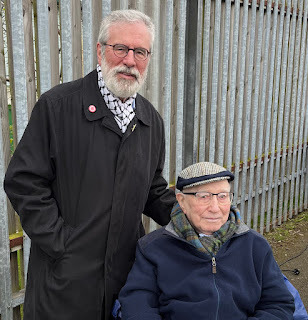 John Montgomery
John MontgomeryStanding up for rights
Among those who attended the Easter Sundaycommemoration in Belfast two weeks ago was John Montgomery. I haven���t seen Johnin many years and it was a delight to meet him again. John is originally fromSt. James��� in west Belfast.
Thirty years ago John was the Chairperson of theBallyfermot Community Association. Those were different times. Politicalcensorship and the demonisation of Republicans was entrenched in governmentpolicy North and South. Collusion between British state agencies and theirunionist paramilitary surrogates was widespread. The Irish and Britishgovernments were locked into a strategy aimed at defeating the IRA and smashingSinn F��in. There was no thought of peace with justice or of conflictresolution; of inclusive talks; or of the centrality of dialogue to resolvedifferences. The establishment was against that.
The Irish political system and sections of themedia were in the forefront of this campaign. Opposition to SinnFein had reached such a fever pitch in the South that Sinn F��in was refused theuse of our usual venue, the Mansion House in Dublin to hold our annual ArdFheis. Other public buildings were denied to us as Fianna Fail, the LabourParty and Fine Gael abused their authority to bar us. The Special Branch wasleaning on hotel owners to put them off hiring venues to us. In 1992 we had noplace to hold our Ard Fheis.
Eventually the Ballyfermot Community Association,in the working class area of Ballyfermot, a sprawling Dublin district notunlike its northern urban cousins in Derry or Belfast, offered us the use oftheir community centre. The Irish establishment was outraged and threatened todeny funding to the community centre but a defiant John Montgomery rejectedthis pointing out that the government hadn���t provided any funding in theprevious 20 years.
Turning a community centre into a venue for the ArdFheis required a lot of hard work and imagination. Lucilita Bhreatnach who wasthen the Ard Runa�� ��� General Secretary of the Party- led our head-office teamto get the logistical and other political back-up in place while a voluntaryteam of painters, carpenters and other construction workers moved in. My oldfriend from Long Kesh, the mural painter Danny Devenney, transformed thecommunity building.
The theme of our 1992 Ard Fheis was ���Towards aLasting Peace in Ireland.��� The title was taken from the document of the samename that we launched in the Ballyfermot Community Centre. At a time when theidea of a peace process was unimaginable ���Towards a Lasting Peace in Irelandsaid: ���An end to conflict is not of itself peace. In the Irishexperience to date it has represented but a pause ��� a postponement of conflictfor a decade or a generation. And end to conflict must of course be anobjective. But to have any lasting value it must be in the context of a peaceprocess which eradicates the causes of the conflict.���
In spite of the Irish establishment���s antipathytoward Sinn F��in the years that followed showed that the Ballyfermot CommunityAssociation was right in opening its centre up to Sinn F��in and Sinn F��in wasright about the need for a peace process. Our efforts along with those ofothers created the opportunity for the Good Friday Agreement. Thank you JohnMontgomery.
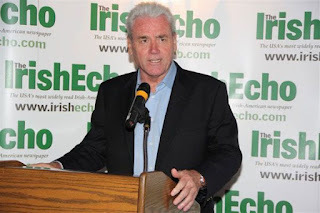
Terry O���Sullivan ��� A working class hero
Terry O'Sullivan is the General President ofthe Laborers' International Union of North American (LIUNA). He has just retiredafter a quarter of century as leader of one of the biggest trade unions inNorth America. I have known Terry O for many years. He is a proud IrishAmerican born in San Francisco and with close ties to Kerry where his paternalgrandfather was from. He still has family there.
LiUNA's slogan is Feel the Power. Terry's mantra isOrganize or Die. Anyone who has heard him deliver one of his rousing speechesknows he means every word of that. He brings that same passion and convictionto his support for Irish Unity, for an end to the partition of Ireland and anew future for all the Irish people.
Terry is a committed united Irelander. He hasspoken at several Sinn F��in Ard Fheiseanna over the years. Terry has alsoaddressed Irish Unity conferences in the USA.
In 2013 he was in Dublin to mark the centenary ofthe Dublin Lockout. In 2016 he headed a big union delegation that came toIreland for the 100th Anniversary of the Easter Rising. He attended events inDublin and here in Belfast including unveiling the statue to James Connollywhich now stands outside ��ras U�� Chonghaile on the Falls Road.
Terry and LiUNA continue to play a leadership rolein making the vision of ��ras U�� Chonghaile a reality. He was one of thespeakers at its formal opening in April 2019 along with President MichaelD Higgins. Last year ��ras U�� Chonghaile dedicated its conference space onthe top floor of the building to Terry renaming it: ���The Terry O���SullivanLiUNA! Conference and Event Space.���
As well as being a trade union leader Terry is alsoa dear friend and a comrade. Over the years I had the pleasure of meetingTerry���s father, Terry Sr. and his mother Leona. They too were strong IrishAmericans and were enormously proud of their son���s many achievements. So alsois the rest of his family and his wife Yvette.
Most recently Terry O travelled to Dublin to attendthe funeral of Rita O���Hare who he had come to know over many years and torespect. He was one of those who acted as guard of honour.
Terry has dedicated his life to advancing the causeof labour and improving the conditions of working people in the USA and aroundthe world. Terry totally understands and embraces Connolly���s analysis thatthe ���Cause of Ireland is the cause of Labour and the Cause of Labour isthe cause of Ireland.���
He may live thousands of miles away but Terry livesthat cause every day and we are forever grateful for it. He may be steppingdown from his leadership role in LiUNA but I know we will continue to advocatefor Irish Unity and in defence of the Good Friday Agreement.
Michelle Gildernew: My memories of the Good FridayAgreement
My memories of the Good Friday Agreement areinterspersed with countless trips across the Irish Sea. I was the Sinn F��inrepresentative in London and on the day the Agreement was reached I was inLondon, where Jimmy and I were staying with Mary Mason, a brilliant Londonbased activist.
In the years preceding that I had been asked by theparty to work in the International Dept, based in Conway Mill and headed up byBairbre de Br��n. I learned a lot there and really enjoyed it, and when the SinnF��in rep in London decided he was ready to come home I was asked to considerreplacing him.
After talking it over with my family and Jimmy, Idecided to relocate, knowing that it was a lot of responsibility but also agreat opportunity. As a result, I had been over in London a few times beforethe first visit to Downing St, and was included in that delegation along withGerry, Richard, Martin, Lucilita, Siobhan and Martin Ferris in December 1997.
When Gerry posted that photo on Instagram lately itsparked all sort of conversations with a new generation of Republicans asking���How come you were asked to go?���, ���why were you in that delegation?���, quicklyfollowed by ������and what age were you?!���
One of my best memories of that day was being in ataxi en route to the airport the day before and hearing on the news that LiamAverill had escaped out of Long Kesh. The bus nearly left the road with thecheer from everyone inside, yet parts of the media portrayed it as ���anembarrassment to the delegation���. We had been joined by the then politicaleditor of the Irish News who can testify that there was no embarrassment, onlydelight!
Looking back now it was a huge honour to beincluded. I remember as we sat in the Cabinet room Tony Blair saying in hisopening remarks that there wouldn���t be a United Ireland in the lifetime of theyoung person in the room, and that was me. Gerry���s response in his openingremarks was ���If someone had told us ten years ago that we would be in 10Downing St. sitting with a British Prime Minister and leader of theLabour Party with your majority we would have said ���not in our lifetime too.���To which Tony Blair replied ���Touch��.���
There is all sorts of possibilities if the will isthere. And then we got down to what turned out to be a very good meeting.
During those times it was extremely busy and wefelt like we were always rushing, to catch planes or to meet deadlines and thefrenetic pace didn���t stop after 10th April 1998.
When others felt their work was done, the Sinn F��inleadership brought the ANC over and organised hundreds of meetings, includingin the jails in order to bring people with us. We had a special Ard Fheis forthe party to take the final decision on the Agreement.
Thinking back the risks taken by Gerry and Martinare in stark contrast to the leadership of other party���s today. We owe GerryAdams and Martin McGuinness a debt of gratitude for the personal and politicalrisks that they took for unity and peace.
Standing up for rights: Terry O’Sullivan – A working class hero: Michelle Gildernew: My memories of the Good Friday Agreement
 John Montgomery
John MontgomeryStanding up for rights
Among those who attended the Easter Sundaycommemoration in Belfast two weeks ago was John Montgomery. I haven’t seen Johnin many years and it was a delight to meet him again. John is originally fromSt. James’ in west Belfast.
Thirty years ago John was the Chairperson of theBallyfermot Community Association. Those were different times. Politicalcensorship and the demonisation of Republicans was entrenched in governmentpolicy North and South. Collusion between British state agencies and theirunionist paramilitary surrogates was widespread. The Irish and Britishgovernments were locked into a strategy aimed at defeating the IRA and smashingSinn Féin. There was no thought of peace with justice or of conflictresolution; of inclusive talks; or of the centrality of dialogue to resolvedifferences. The establishment was against that.
The Irish political system and sections of themedia were in the forefront of this campaign. Opposition to SinnFein had reached such a fever pitch in the South that Sinn Féin was refused theuse of our usual venue, the Mansion House in Dublin to hold our annual ArdFheis. Other public buildings were denied to us as Fianna Fail, the LabourParty and Fine Gael abused their authority to bar us. The Special Branch wasleaning on hotel owners to put them off hiring venues to us. In 1992 we had noplace to hold our Ard Fheis.
Eventually the Ballyfermot Community Association,in the working class area of Ballyfermot, a sprawling Dublin district notunlike its northern urban cousins in Derry or Belfast, offered us the use oftheir community centre. The Irish establishment was outraged and threatened todeny funding to the community centre but a defiant John Montgomery rejectedthis pointing out that the government hadn’t provided any funding in theprevious 20 years.
Turning a community centre into a venue for the ArdFheis required a lot of hard work and imagination. Lucilita Bhreatnach who wasthen the Ard Runaí – General Secretary of the Party- led our head-office teamto get the logistical and other political back-up in place while a voluntaryteam of painters, carpenters and other construction workers moved in. My oldfriend from Long Kesh, the mural painter Danny Devenney, transformed thecommunity building.
The theme of our 1992 Ard Fheis was ‘Towards aLasting Peace in Ireland.’ The title was taken from the document of the samename that we launched in the Ballyfermot Community Centre. At a time when theidea of a peace process was unimaginable ‘Towards a Lasting Peace in Irelandsaid: “An end to conflict is not of itself peace. In the Irishexperience to date it has represented but a pause – a postponement of conflictfor a decade or a generation. And end to conflict must of course be anobjective. But to have any lasting value it must be in the context of a peaceprocess which eradicates the causes of the conflict.”
In spite of the Irish establishment’s antipathytoward Sinn Féin the years that followed showed that the Ballyfermot CommunityAssociation was right in opening its centre up to Sinn Féin and Sinn Féin wasright about the need for a peace process. Our efforts along with those ofothers created the opportunity for the Good Friday Agreement. Thank you JohnMontgomery.

Terry O’Sullivan – A working class hero
Terry O'Sullivan is the General President ofthe Laborers' International Union of North American (LIUNA). He has just retiredafter a quarter of century as leader of one of the biggest trade unions inNorth America. I have known Terry O for many years. He is a proud IrishAmerican born in San Francisco and with close ties to Kerry where his paternalgrandfather was from. He still has family there.
LiUNA's slogan is Feel the Power. Terry's mantra isOrganize or Die. Anyone who has heard him deliver one of his rousing speechesknows he means every word of that. He brings that same passion and convictionto his support for Irish Unity, for an end to the partition of Ireland and anew future for all the Irish people.
Terry is a committed united Irelander. He hasspoken at several Sinn Féin Ard Fheiseanna over the years. Terry has alsoaddressed Irish Unity conferences in the USA.
In 2013 he was in Dublin to mark the centenary ofthe Dublin Lockout. In 2016 he headed a big union delegation that came toIreland for the 100th Anniversary of the Easter Rising. He attended events inDublin and here in Belfast including unveiling the statue to James Connollywhich now stands outside Áras Uí Chonghaile on the Falls Road.
Terry and LiUNA continue to play a leadership rolein making the vision of Áras Uí Chonghaile a reality. He was one of thespeakers at its formal opening in April 2019 along with President MichaelD Higgins. Last year Áras Uí Chonghaile dedicated its conference space onthe top floor of the building to Terry renaming it: “The Terry O’SullivanLiUNA! Conference and Event Space.”
As well as being a trade union leader Terry is alsoa dear friend and a comrade. Over the years I had the pleasure of meetingTerry’s father, Terry Sr. and his mother Leona. They too were strong IrishAmericans and were enormously proud of their son’s many achievements. So alsois the rest of his family and his wife Yvette.
Most recently Terry O travelled to Dublin to attendthe funeral of Rita O’Hare who he had come to know over many years and torespect. He was one of those who acted as guard of honour.
Terry has dedicated his life to advancing the causeof labour and improving the conditions of working people in the USA and aroundthe world. Terry totally understands and embraces Connolly’s analysis thatthe “Cause of Ireland is the cause of Labour and the Cause of Labour isthe cause of Ireland.”
He may live thousands of miles away but Terry livesthat cause every day and we are forever grateful for it. He may be steppingdown from his leadership role in LiUNA but I know we will continue to advocatefor Irish Unity and in defence of the Good Friday Agreement.
Michelle Gildernew: My memories of the Good FridayAgreement
My memories of the Good Friday Agreement areinterspersed with countless trips across the Irish Sea. I was the Sinn Féinrepresentative in London and on the day the Agreement was reached I was inLondon, where Jimmy and I were staying with Mary Mason, a brilliant Londonbased activist.
In the years preceding that I had been asked by theparty to work in the International Dept, based in Conway Mill and headed up byBairbre de Brún. I learned a lot there and really enjoyed it, and when the SinnFéin rep in London decided he was ready to come home I was asked to considerreplacing him.
After talking it over with my family and Jimmy, Idecided to relocate, knowing that it was a lot of responsibility but also agreat opportunity. As a result, I had been over in London a few times beforethe first visit to Downing St, and was included in that delegation along withGerry, Richard, Martin, Lucilita, Siobhan and Martin Ferris in December 1997.
When Gerry posted that photo on Instagram lately itsparked all sort of conversations with a new generation of Republicans asking“How come you were asked to go?”, “why were you in that delegation?”, quicklyfollowed by “…and what age were you?!”
One of my best memories of that day was being in ataxi en route to the airport the day before and hearing on the news that LiamAverill had escaped out of Long Kesh. The bus nearly left the road with thecheer from everyone inside, yet parts of the media portrayed it as “anembarrassment to the delegation”. We had been joined by the then politicaleditor of the Irish News who can testify that there was no embarrassment, onlydelight!
Looking back now it was a huge honour to beincluded. I remember as we sat in the Cabinet room Tony Blair saying in hisopening remarks that there wouldn’t be a United Ireland in the lifetime of theyoung person in the room, and that was me. Gerry’s response in his openingremarks was “If someone had told us ten years ago that we would be in 10Downing St. sitting with a British Prime Minister and leader of theLabour Party with your majority we would have said “not in our lifetime too.”To which Tony Blair replied “Touché.”
There is all sorts of possibilities if the will isthere. And then we got down to what turned out to be a very good meeting.
During those times it was extremely busy and wefelt like we were always rushing, to catch planes or to meet deadlines and thefrenetic pace didn’t stop after 10th April 1998.
When others felt their work was done, the Sinn Féinleadership brought the ANC over and organised hundreds of meetings, includingin the jails in order to bring people with us. We had a special Ard Fheis forthe party to take the final decision on the Agreement.
Thinking back the risks taken by Gerry and Martinare in stark contrast to the leadership of other party’s today. We owe GerryAdams and Martin McGuinness a debt of gratitude for the personal and politicalrisks that they took for unity and peace.
April 16, 2023
Back in the USA: Ceol: Alex Maskey reflects on the Good Friday Agreement
Back in the USA
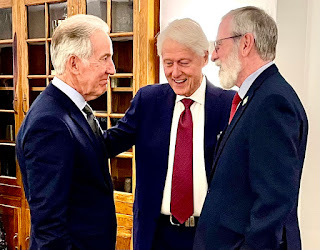
The 25th anniversary of the GoodFriday Agreement has attracted considerable national and international interestin recent weeks. Part of this involved me travelling last week once again tothe USA. It must be four years since I was last there. While a lot has changedpolitically in that time both here and in the U.S. some things never change –among them the multiple stamping in red capitals of SSSS (SecondarySecurity Screening Selection) on ourboarding passes and suitcase labels. It is explained as a random processwhereby travellers are selected for ‘enhanced’ searches. I have been gettingthe SSSS stamp on every visit to andfrom the USA for over 20 years. Randomly routine.
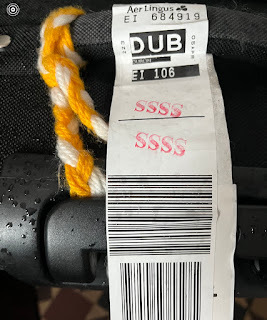 But apart from that the visit was an opportunity tocatch up with many old friends and thank them for the crucial role they playedin 1998 and continue to play today. If Irish America ever had any doubt aboutits political strength it was evident last week in President Clinton’s presencein a Cooper Union event in New York, the visit by President Joe Biden toIreland – North and South – this week and the expected presence of PresidentClinton and former Secretary of State Hillary Clinton at events in Belfast thisweekend.
But apart from that the visit was an opportunity tocatch up with many old friends and thank them for the crucial role they playedin 1998 and continue to play today. If Irish America ever had any doubt aboutits political strength it was evident last week in President Clinton’s presencein a Cooper Union event in New York, the visit by President Joe Biden toIreland – North and South – this week and the expected presence of PresidentClinton and former Secretary of State Hillary Clinton at events in Belfast thisweekend.
The Cooper Union event was hosted by seven IrishAmerican organisations; The Irish-American Unity Conference; the Friends OfSinn Féin; Ancient Order of Hibernians; The Friendly Sons of St. Patrick;Brehon Law Society; James Connolly Irish American Labor Coalition; and LadiesAncient Order of Hibernians. President Clinton reminded the audience of thechallenges he then faced in engaging with the process, of the decisions hetook, including giving me that first all-important 48 hour New York visa inJanuary 1994 and his appointment of George Mitchell. He was forthright in hiscall for the Assembly and the Executive to be restored.
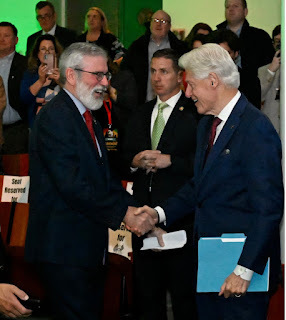 The following night I spoke at a dinner hosted bythe Martin McGuinness Peace Foundation. Thanks to Marty Glennon and friends fortheir involvement in both events.
The following night I spoke at a dinner hosted bythe Martin McGuinness Peace Foundation. Thanks to Marty Glennon and friends fortheir involvement in both events.
The day after I returned from the USA I was inParliament Buildings. The Assembly Speaker Alex Maskey had organised a reallygood ceremony to mark 25 anniversary of the Agreement. Entitled – A NewBeginning – the event brought together many of those who had taken part in thenegotiations to reflect on the process and its outcome.
The choir of the Belfast School of Performing Artswere outstanding and the young people from the Youth Assembly who introducedeach of the speakers were a reminder that the future we are building is aninvestment in their future. Thanks also to Dana Masters for her songs.
I said that I believe Jeffrey Donaldson when hesays that First Minister designate Michelle O’Neill taking up that office isnot a problem for him. So when the DUP has concluded its internal processes allof us can look forward to a new phase of the northern Assembly. No otherscenario is viable.
Of course that does not mean that everyone elseshould sit around twiddling our thumbs waiting for the DUP. The presentEnglish government has no real investment in the Agreement. So there is a heavyonus on the Irish government to use all the Good Friday Agreement mechanisms,including
Our responsibility is for the future. The past willtake care of itself. Let’s plan for the day when we will all govern ourselveswithout the corrosive rule of London.
In the last 25 years we have fallen down manytimes. In fact we are very good at that. But we also are good at getting backup again. We are very successful at that. Let’s be successful once again.
Alex with his mother Teresa after his election in 2002 as Mayor.
This week Alex Maskey shares his reflections on thenegotiations for the Good Friday Agreement 25 years ago.
Reflections on the GFA
They say a week is a long time in politics. Thismonth we mark the 25th anniversary of the Good Friday Agreementand we all should reflect on why it is that the Agreement is not yet fullyimplemented.
One thing is certain and that is that republicanismis stronger now across the island than it has been at any time in this pastcentury, with the continuing growth of Sinn Fein and emergence of civic UnitedIrelanders while other progressives search for a political home includingwithin a new Ireland. I believe that the GFA itself remains a work in progresshowever I also believe passionately that it has successfully set the templatefor all of our politics since 1998.
I would say however with some frustrationthat many commentators often name check a number of participants and leaders inthe negotiations. I won’t take away from the contributions made by many inmaking the agreement possible and effectively helping to end what had been thelatest 30 year phase of conflict. But rarely do those same commentators getbeyond citing Martin McGuinness or even Gerry Adams (on a good day) asarchitects of the GFA despite the critical role played by them both and manyothers. But that’s a discussion for another day.
Building the peace process through the mid-ninetieswas met with many challenges. However progress was made though perhaps with twosteps forward and one step back until 1997 when all changed. In 1997 Sinn Feinwas eventually formally admitted into the Talks at Castle Buildings,Stormont.
As a member of our Talks team I had the greatpleasure to work closely on a day to day basis with our late and dear friendSiobhan O’Hanlon who managed our administration with absolute professionalismand discipline. Part of my own work was to ensure that as many of our localparty organisers and elected representatives could visit to either observe orparticipate in some element of the Talks process in order to give as many aspossible greater insight into the process of negotiations. For us this wasessential to underline to our members the premise that negotiations shouldalways be much more than what goes on “in the room.” In the room or outside theroom as activists we all had to complement each other by campaigning, fightingelections, engaging with our communities and winning the arguments we faceddaily.
At times as we moved closer to an Agreement thepace was frantic which only served to keep our team even more focussed on thejob in hand. But I must say it was also at times nerve wrecking because we allunderstood how pivotal and important, even historical, that an actual peaceagreement could be reached under our watch.
Once agreement was reached on Good Friday under thebrilliant leadership of US Senator George Mitchel we knew that our work wasonly just beginning as we set about establishing a new Assembly etc but thatthe experience we had gained would serve us very well.
Ceol
I love music. All kinds of music. I listen to theradio a lot. I still have cassette tapes and vinyl from the 1970’s. I play themalso. And CDs. And an iPod. I also have music on my phone. Every sooften my devices organise my music into a Favourite Mix. For those of you whoshare my love for music here’s a sample of what my phone has selected. Itincludes Bruce Springsteen and James Taylor. The Byrds. Them.

KathleenThompson. Sharon Shannon. John Spillane. Christy. Lisa O Neill. The BothyBand.Cormac Breathnach. The Animals. Mary Coughlan. Planxty. Liam OFlynn. Frances and May Black. The Gloaming. Bob Dylan. John Prine. Pavoratti.Leonard Cohen. Cormac Begley. Ry Cooder Altan. Willie Nelson. PaddyGlackin.John mc Cormack. Caitlín Maude. The Chieftains.Ray Charles. PeteSeeger. Sean O Sé. Clannad. The Saw Doctors. Luka Bloom.Muireann Nic Amhlaoibh. Joe Heaney. Simon and Garfunkel. The Rolling Stones.Beatles. Skara Brae. Woody Gutherie. Van Morrison. Willie Nelson.Eileen Ivers.
Like books, dogs and children it’s hard to pick afavourite song or musician. I love many many more. Let themusic keep your spirits high.
April 11, 2023
A Warm House for Everyone: Seeking a Pathway to the Future by Lucilita Bhreatnach: Wear an Easter Lily
A Warm House for Everyone
Iam writing this column in New York. Richard and I are here for the weekendworking on my remarks for Monday night when President Bill Clinton and I willshare reflections on the Good Friday Agreement negotiations and developmentssince then. I will return to this in next week’s column.
PresidentClinton played a critical role in the build up to the Agreement, encouraged andsupported by Irish America. He was at the end of the phone as agreement wasreached and has been an enabler of our process ever since. So too has HilaryClinton.
OurMonday night event is in Cooper Union Great Hall. I’ve spoken there oncebefore. So has Abraham Lincoln, Barak Obama, Bill Clinton and a range of otherrenowned speakers from the Arts, Science, politics and activist sectors. Justsaying.
‘Ifyou can make it here you can make it anywhere’ says Richard.
Ourlast event before leaving Ireland for New York was a Peoples’ Assembly inthe Carrickdale Hotel in Carrickcarnon, right on the border in CountyLouth. This Peoples’ Assembly was an opportunity for citizens fromthe Armagh, Down and Louth border region to have their say on the futureof Ireland.
Theill-effects of living under British rule are keenly felt in this area and theimplications of Brexit casts a long shadow. So too does the BritishGovernment’s Legacy Bill of Shame and its mean spirited ‘Borders andNationalities Bill’ which makes it mandatory for visitors travelling into theNorth from the South to firstly obtain an Electronic TravelAuthorisation. This is the latest threat from London to the peoplehere particularly in this region.
The Carrickdaleevent was the fourth organised by Sinn Féin’s Commission on the Future ofIreland. It was chaired by ConorPatterson of Newry and Mourne Enterprise Agency. The panel included; ReverendKaren Sethuraman; ICTU Assistant General Secretary Gerry Murphy; MairéadMcAlinden former CEO of the Southern Health & Social Care Trust and AidanBrowne of Dundalk’s DkIt's Regional Development Centre.
Theygave valuable insights and their contributions were well worth listening to. Soalso were contributions from the audience. They were thoughtful, spirited,informed and very interesting for me, as someone not from that region, as wellI am sure for everyone else.
It was standing room only and the packed gatheringheard Uachtarán Shinn Féin Mary Lou McDonald open the event.
Ina wide ranging address Mary Lou spelt out the difficulties caused by partitionand the opportunities which will be created by ending division and sheaddressed the importance of reaching out to our unionist neighbours. Shesaid: “We want to encourage popular grass roots participation in that ongoingconversation about our shared future. Everyone should have their say. There aremany people in this region who are unionist. The Orange was foundedin neighbouring county Armagh.
Thattradition is reflected in our national colours. This is the place that weall call home. Our resolve is to make it a better place for all, unionists areour neighbours and they should also be our friends’.
Thiscolumn hopes that Jeffrey Donaldson’s DUP officer board picked up on this.
The SinnFéin President extended the hand of friendship to them when she said: “Tothose from the unionist culture I extend a sincere welcome – the new Irelandmust be a warm house for all and your traditions and beliefs must be respectedand cherished. I invite you especially to be part of the conversation and forus all to plan for the future together … Conversations are happening across thecountry – in our places of work, in our universities, as we drop our childrenat the school gates and at the match on Sundays!”
In recent years a vast amount of academic research,new studies and books on all aspects of reunification have been produced. Theyall urge the Irish Government to begin planning and preparing forconstitutional change and there is now an urgent imperative for the governmentto establish a Citizen’s Assembly to prepare the groundwork in advance of aunity referendum.
As Mary Lou said: “This is an exciting time forus all; filled with opportunity and hope for a better future. That’s whywe need to get it right. Our new constitutional national democracy willemerge from a phased transition and that is why planning and preparation shouldbegin now. Grassroots communities should be involved at the beginning of thatprocess, not at the end.”
The Sinn Fein President pointed out that theCommission on the Future of Ireland is about inviting working people, tradeunionists, business owners, community activists, women, our youth, LGBTQpeople, Gaeilgeoirí, academics, our new communities, Travellers, those withdisabilities and others to have their say on the process of change.
Speaking directly about the challenges facing theborder region Mary Lou said: “Our shared challenge is to create a futurewhich is warm and welcoming for everyone and where the potential prosperity ofareas like this border region can be fully unlocked.”
Sothere you have it. Perhaps when this column returns to Ireland the DUP attitudeto participating in the Northern Assembly will be clearer.
Or,perhaps not?
This weekLucilita Bhreatnach, one of our negotiators at Good Friday 1998 recalls theseevents.
Each one of us involved in thenegotiations has their reminiscences of the days leading up to the Good FridayAgreement. Also, of the preceding years, talks about talks and then, the actualtalks with the three governments, Dublin, London and the White House.
We were seeking a pathway into thefuture. Negotiations involve taking risks, listening to the other side andbeing willing to move into a new space. Every obstacle we faced had to be overcomeor talks would have broken down on many occasions.
Our negotiation teams comprised partymembers, including ex-prisoners and elected representatives. We were pursuing apeaceful and democratic solution to an undemocratic situation. England's policyin Ireland was still resisting that democratic outcome.
In the late hours of April 1998, therewere tensions and bad tempers, emotional and technical problems; loads of bi-lateralsand papers galore. The party leadership had resolved to engage and to reach anagreement, if possible based on the democratic principles governing our outlookon the negotiation process.
At some stage Bairbre De Brún, AlexMaskey and I found ourselves in a room with officials checking on papers lateinto the night. We engaged on human rights issues, a Bill of Rights, policingand the Irish language.
In a corridor, I bumped into BertieAhern and he said ‘tell Martin and Gerry I have told them we are not giving anymore.’ I put an Easter lily into the palm of his hand and offered mysympathies, as his mother had died that week.
Some days earlier, I drove to Dublin tobe with my daughter for the birth of her first child, Aoife. Back in Stormont,Bríd Curran gave me a card signed by the team for Aoife.
We waited all night long. At some stageMitchel McLoughlin, Bairbre and I addressed the media outside in the freezingsnow. We tried to keep hope alive but the talks were confidential and none ofus wanted any damaging leaks to the media. Bairbre and I did the internationalmedia, in Spanish and French agus as Gaeilge.
Back inside, Siobhán and I sat next toa photocopying machine in the hall ready to copy the all-important documentonce it arrived when the Unionist reached a decision.
There were phone calls back and forthwith the prisoners. It felt surreal at times. We knew we were on the cusp ofsomething big but also that we would not get everything we wanted.
Gerry and Martin appeared, documentswere handed out, which we all read. No time then for much sleep for we had toget ready for the plenary session chaired by George Mitchell. I had met him inthe hall and he shook my hand saying ‘you did very well’, (meaning all of us Iam sure).
When formalities were over one of theloyalists told me he had studied Irish and got a Fáinne while in jail.
Twenty-five years later, the GoodFriday Agreement has yet to be fully implemented along with other agreements. Ilook forward to a New Ireland that is multicultural, pluralist and nonsectarian based on equality with full inclusion of the Unionist and othercommunities in Ireland.
Wear an Easter Lily
Easter is only days away.It is a time when tens of thousands of people across the island, andinternationally, will attend Easter commemorations to mark the anniversary ofthe Easter Rising and the Proclamation of the Republic. The symbol of ourenduring commitment to those ideals is the Easter Lily.
The first Easter Lily badges were designed in 1925by Cumann na mBan. The dual purpose of the Easter Lily was to raise money forthe Republican Prisoners’ Dependents Fund and to honour the sacrifice made bythe men and women of the 1916 Rising. The original Easter Lily badge washand-made.
So, wear an Easter Lilythis weekend with pride and in remembrance of past generations.
Gerry Adams's Blog
- Gerry Adams's profile
- 29 followers


